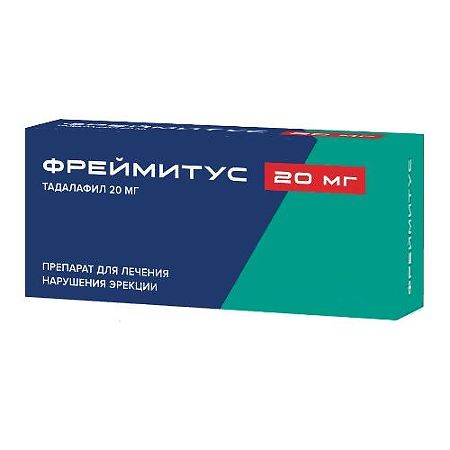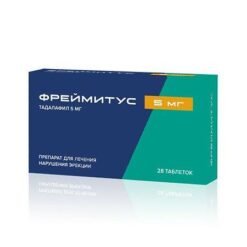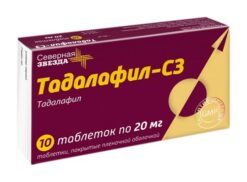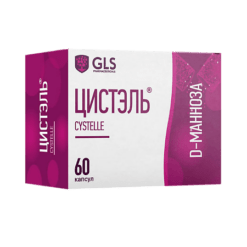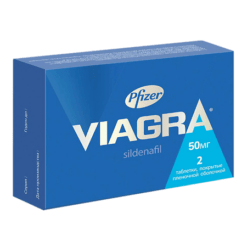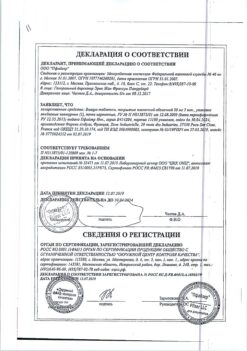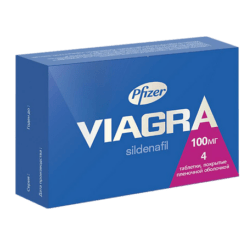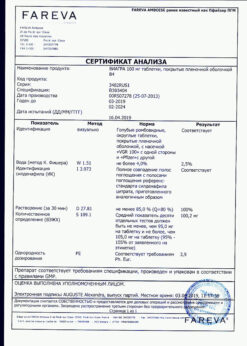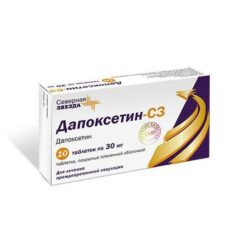No products in the cart.
Freimitus, 20 mg 4 pcs
€1.00
Out of stock
(E-mail when Stock is available)
Description
Tadalafil is a reversible selective inhibitor of specific phosphodiesterase type 5 (FDE-5) cyclic guanosine monophosphate (cGMP). When sexual arousal causes local release of nitric oxide, inhibition of FDE-5 by tadalafil leads to increased concentration of cGMP in the cavernous body of the penis. The consequence of this is relaxation of arterial smooth muscles and blood flow to the tissues of the penis, which causes an erection.
In vitro studies have shown that tadalafil is a selective inhibitor of FDE-5. FDE-5 is an enzyme present in the smooth muscle of the cavernous body, vessels and internal organs, in skeletal muscles, platelets, kidneys, lungs and cerebellum. The action of tadalafil on FDE-5 is more active than on other phosphodiesterases. Tadalafil is 10,000 times more potent against FDE-5 than other types of phosphodiesterases (FDE-1, FDE-2, FDE-4, and FDE-7), which are localized in the heart, brain, blood vessels, liver, white blood cells, and other organs. Tadalafil is 10,000 times more active in blocking FDE-5 than FDE-3, an enzyme found in the heart and blood vessels. This selectivity for FDE-5 over FDE-3 is important because FDE-3 is an enzyme involved in heart muscle contraction. In addition, tadalafil is about 700 times more active against FDE-5 than against FDE-6, which is found in the retina and is responsible for phototransmission. Tadalafil is 9,000 times more potent against FDE-5 than it is against FDE-8, FDE-9, and FDE-10, and 14 times more potent than it is against FDE-11. Distribution in tissues and physiological effects of FDE-8 – FDE-11 inhibition have not yet been clarified.
Tadalafil in healthy volunteers does not cause significant changes in systolic and diastolic blood pressure compared to placebo in the prone position (mean maximum decrease is 1.6 and 0.8 mm Hg, respectively). Tadalafil does not cause significant changes in heart rate.
Tadalafil does not cause changes in color recognition (blue/green) due to its low affinity for FDE-6. In addition, there is no effect of tadalafil on visual acuity, electroretinogram, intraocular pressure and pupil size.
Several studies have been conducted to evaluate the effect of daily tadalafil administration on spermatogenesis. None of the studies observed an undesirable effect on sperm morphology and motility. One study found a decrease in average sperm concentration compared to placebo. The decrease in sperm concentration was associated with a higher frequency of ejaculation. In addition, when comparing tadalafil with placebo there was no undesirable effect on the average concentration of sex hormones (testosterone, luteinizing hormone and follicle stimulating hormone).
Erectile Dysfunction (ED)
In the conducted studies tadalafil showed statistically significant improvement in erectile function and the ability to perform a full sexual intercourse. Tadalafil has no effect in the absence of sexual arousal.
The effectiveness and safety of tadalafil have been studied in clinical trials. Improvement of erection in patients with ED of all degrees of severity when taking 5 mg of tadalafil once a day within 36 hours after intake, and maintenance of erection within 16 minutes after intake compared to placebo was noted. In studies of primary efficacy of tadalafil 5 mg, 57% and 67% of sexual attempts were successful, compared with 31% and 37% when taking placebo. In studies of patients with secondary ED on a background of diabetes, 41% of sexual attempts were successful compared to 28% on placebo.
Benign prostatic hyperplasia (BPH)
In patients with BPH, tadalafil, by inhibiting FDE-5, leads to increase of cGMP concentration not only in cavernous body of penis but also in smooth muscles of prostate, bladder and blood vessels that supply them. It in its turn increases perfusion of blood in these organs and, as a consequence, reduces severity of BPH symptoms. Relaxation of the smooth muscles of the prostate and bladder and inhibition of afferent innervation of the bladder may further enhance the vascular effects.
Clinical studies have shown a reduction in symptoms of BPH within 1 week after taking 5 mg of tadalafil compared to placebo.
In studies including patients with ED and symptoms of BPH, 71.9% of sexual attempts were successful with tadalafil 5 mg compared to 48.3% with placebo, and there was a significant improvement in erectile function and reduction in prostate symptoms.
Pharmacokinetics
Absorption
After oral administration, tadalafil is rapidly absorbed. Average maximum concentration (Cmax) in blood plasma is reached on average in 2 hours after oral administration.
Speed and degree of absorption of tadalafil do not depend on food intake, so the drug can be used regardless of food intake. The time of administration (morning or evening) has no clinically significant effect on the rate and extent of absorption.
The pharmacokinetics of tadalafil in healthy volunteers is linear with respect to time and dose. In the dose range of 2.5 to 20 mg, the area under the concentration-time curve (AUC) increases in proportion to the dose. Equilibrium plasma concentrations are reached within 5 days if the drug is taken once daily. Pharmacokinetics of tadalafil in patients with erectile dysfunction is similar to pharmacokinetics of the drug in patients without erectile dysfunction.
Distribution
Average volume of distribution is about 63 l, indicating that tadalafil is distributed in body tissues.
In therapeutic concentrations 94% of tadalafil is bound to plasma proteins. Binding to plasma proteins is not altered in impaired renal function.
In healthy volunteers, less than 0.0005% of the administered dose is found in semen.
Metabolism
Tadalafil is mainly metabolized with participation of the CYP3A4 cytochrome P450 isoenzyme. The main circulating metabolite is methylcatecholglucuronide. This metabolite is at least 13,000 times less active against FDE-5 than tadalafil. Consequently, the concentration of this metabolite is not clinically relevant.
Excretion
In healthy volunteers, the average clearance of tadalafil when taken orally is 2.5 L/h and the average elimination half-life (T1/2) is 17.5 h. Tadalafil is primarily excreted as inactive metabolites primarily by the intestine (about 61% of the dose) and, to a lesser extent, by the kidneys (about 36% of the dose).
Older patients
Healthy older volunteers (65 years and older) had a lower clearance of tadalafil when ingested, as reflected by a 25% increase in AUC compared to healthy volunteers aged 19 to 45 years. This difference is not clinically significant and does not require dose adjustment.
Patients with Renal Impairment
Clinical studies have shown that a single dose of tadalafil (5-20 mg) increases AUC by approximately 2-fold in patients with mild (creatinine clearance (CK) 51-80 ml/min), moderate (CK 31-50 ml/min) and terminal renal impairment (performing dialysis). In patients on hemodialysis, the Cmax of tadalafil is 41% higher than in healthy volunteers. Tadalafil is virtually not excreted by hemodialysis.
Patients with hepatic impairment
The pharmacokinetics of tadalafil in patients with mild to moderate hepatic impairment (Child-Pugh grades A and B) are comparable to those of healthy volunteers. For patients with severe hepatic impairment (Child-Pugh class C), data are limited, so a benefit/risk assessment should be performed before using the drug.
Patients with diabetes
Patients with diabetes during tadalafil use have an AUC approximately 19% lower than in healthy volunteers. This difference does not require a dose adjustment.
Indications
Indications
erectile dysfunction;
lower urinary tract symptoms in patients with BPH (for a dosage of 5 mg);
erectile dysfunction in patients with urinary tract symptoms in patients with BPH (for a dosage of 5 mg).
Pharmacological effect
Pharmacological effect
Tadalafil is a reversible selective inhibitor of specific phosphodiesterase type 5 (PDE-5) of cyclic guanosine monophosphate (cGMP). When sexual arousal causes local release of nitric oxide, inhibition of PDE5 by tadalafil leads to increased concentrations of cGMP in the corpus cavernosum of the penis. The consequence of this is the relaxation of the smooth muscles of the arteries and the flow of blood to the tissues of the penis, which causes an erection.
In vitro studies have shown that tadalafil is a selective PDE5 inhibitor. PDE-5 is an enzyme present in the smooth muscles of the corpus cavernosum, blood vessels and internal organs, skeletal muscles, platelets, kidneys, lungs and cerebellum. The effect of tadalafil on PDE-5 is more active than on other phosphodiesterases. Tadalafil is 10,000 times more potent against PDE-5 than against other types of phosphodiesterase (PDE-1, PDE-2, PDE-4 and PDE-7), which are localized in the heart, brain, blood vessels, liver, white blood cells and other organs. Tadalafil is 10,000 times more potent at blocking PDE-5 than PDE-3, an enzyme found in the heart and blood vessels. This selectivity for PDE-5 over PDE-3 is important because PDE-3 is an enzyme involved in cardiac muscle contraction. In addition, tadalafil is approximately 700 times more active against PDE5 than PDE6, which is found in the retina and is responsible for phototransmission. The effect of tadalafil on PDE-5 is 9000 times more pronounced than its effect on PDE-8, PDE-9 and PDE-10, and 14 times more pronounced than on PDE-11. The tissue distribution and physiological effects of PDE-8 – PDE-11 inhibition have not yet been clarified.
Tadalafil in healthy volunteers does not cause significant changes in systolic and diastolic blood pressure compared to placebo in the supine position (mean maximum decrease is 1.6 and 0.8 mm Hg, respectively) and in the standing position (mean maximum decrease is 0.2 and 4.6 mm Hg, respectively).
Tadalafil does not cause a significant change in heart rate.
Tadalafil does not cause changes in color recognition (blue/green), which is explained by its low affinity for PDE-6. In addition, there was no effect of tadalafil on visual acuity, electroretinogram, intraocular pressure and pupil size.
Several studies have been conducted to evaluate the effect of daily tadalafil on spermatogenesis. No adverse effects on sperm morphology or motility were observed in any of the studies. One study found a decrease in mean sperm concentration compared to placebo. Decreased sperm concentration was associated with higher ejaculation frequency. In addition, when comparing tadalafil with placebo, no adverse effects on the mean concentrations of sex hormones (testosterone, luteinizing hormone and follicle-stimulating hormone) were observed.
Erectile dysfunction (ED)
In studies conducted, tadalafil showed a statistically significant improvement in erectile function and the ability to have full sexual intercourse. Tadalafil has no effect in the absence of sexual arousal.
The effectiveness and safety of tadalafil have been studied in clinical studies. An improvement in erection was noted in patients with ED of all degrees of severity when taking 5 mg of tadalafil once a day for 36 hours after administration, as well as maintaining an erection for 16 minutes after administration compared with placebo. In the primary efficacy studies of 5 mg tadalafil, 57% and 67% of attempted intercourse were successful compared with 31% and 37% with placebo. In studies of patients with ED secondary to diabetes, 41% of attempts at intercourse were successful compared to 28% with placebo.
Benign prostatic hyperplasia (BPH)
In patients with BPH, tadalafil, by inhibiting PDE-5, leads to an increase in the concentration of cGMP not only in the cavernous body of the penis, but also in the smooth muscles of the prostate gland, bladder and the vessels that supply them. This in turn increases blood perfusion in these organs and, as a result, reduces the severity of BPH symptoms. Relaxation of prostate and bladder smooth muscle and inhibition of bladder afferent innervation may further enhance vascular effects.
Clinical studies have shown a reduction in BPH symptoms within 1 week of taking 5 mg tadalafil compared to placebo.
In studies involving patients with ED and BPH symptoms, tadalafil 5 mg was successful in 71.9% of intercourse attempts compared to 48.3% with placebo, and there was a significant improvement in erectile function and prostate symptoms.
Pharmacokinetics
Suction
After oral administration, tadalafil is rapidly absorbed. The average maximum concentration (Cmax) in blood plasma is achieved on average 2 hours after oral administration.
The rate and extent of absorption of tadalafil do not depend on food intake, so the drug can be used regardless of food intake. Time of administration (morning or evening) has no clinically significant effect on the rate or extent of absorption.
The pharmacokinetics of tadalafil in healthy volunteers is linear with respect to time and dose. In the dose range from 2.5 to 20 mg, the area under the concentration-time curve (AUC) increases proportionally to the dose. Equilibrium concentrations in blood plasma are achieved within 5 days when taking the drug once a day. The pharmacokinetics of tadalafil in patients with erectile dysfunction are similar to the pharmacokinetics of the drug in patients without erectile dysfunction.
Distribution
The average volume of distribution is approximately 63 L, which indicates that tadalafil is distributed into body tissues.
At therapeutic concentrations, 94% of tadalafil binds to plasma proteins. Plasma protein binding is not affected by impaired renal function.
In healthy volunteers, less than 0.0005% of the administered dose was found in semen.
Metabolism
Tadalafil is mainly metabolized with the participation of the cytochrome P450 isoenzyme CYP3A4. The main circulating metabolite is methylcatechol glucuronide. This metabolite is at least 13,000 times less active against PDE5 than tadalafil. Therefore, the concentration of this metabolite is not clinically significant.
Removal
In healthy volunteers, the average clearance of tadalafil when taken orally is 2.5 l/h, and the average half-life (T1/2) is 17.5 hours. Tadalafil is excreted primarily in the form of inactive metabolites, mainly by the intestines (about 61% of the dose) and, to a lesser extent, by the kidneys (about 36% of the dose).
Elderly patients
Healthy elderly volunteers (65 years and older) had lower oral clearance of tadalafil, resulting in a 25% increase in AUC compared to healthy volunteers aged 19 to 45 years. This difference is not clinically significant and does not require dose adjustment.
Patients with renal failure
Clinical studies have shown that when taking a single dose of tadalafil (5-20 mg), AUC increases approximately 2-fold in patients with mild (creatinine clearance (CR) 51-80 ml/min), moderate (CR 31-50 ml/min) and end-stage renal failure (dialysis). In hemodialysis patients, the Cmax of tadalafil is 41% higher than in healthy volunteers. Tadalafil is practically not excreted during hemodialysis.
Patients with liver failure
The pharmacokinetics of tadalafil in patients with mild to moderate hepatic impairment (Child-Pugh classes A and B) are comparable to those in healthy volunteers. For patients with severe hepatic impairment (Child-Pugh class C), data are limited, so a benefit/risk assessment must be made before using the drug.
Patients with diabetes
In patients with diabetes mellitus, tadalafil AUC is approximately 19% less than in healthy volunteers. This difference does not require dose adjustment.
Special instructions
Special instructions
Diagnosis of ED and BPH should include identification of the underlying cause of the disease, appropriate medical examination, determination of treatment tactics and individual assessment of the benefit/risk ratio. Sexual activity has potential risks for patients with cardiovascular disease, so treatment for ED should not be used in men with heart disease for which sexual activity is not recommended.
Like other PDE-5 inhibitors, tadalafil can have a systemic vasodilatory effect, which can lead to a transient decrease in blood pressure and increased hypotensive effect of nitrates and alpha-blockers (see section “Interaction with other drugs”). Before prescribing the drug, it is necessary to carefully assess the likelihood of such adverse reactions in patients with cardiovascular diseases.
Patients suspected of having BPH should undergo testing to rule out prostate cancer.
Non-arterial anterior ischemic optic neuropathy (NAION) causes visual impairment, including complete loss of vision. There are rare post-marketing reports of cases of the development of NAPION, temporally associated with the use of PDE-5 inhibitors. It is currently impossible to determine whether there is a direct relationship between the development of NAPION and the use of PDE5 inhibitors or other factors. Patients should be warned that if sudden vision loss occurs, they should stop taking tadalafil and seek medical attention. Patients should also be informed that people who have had NAPI are at increased risk of developing NAPI again.
There are reports of priapism with the use of PDE5 inhibitors, including tadalafil. Patients should be informed of the need to seek immediate medical attention if an erection occurs that lasts 4 hours or more. Untimely treatment of priapism leads to damage to the tissue of the penis, which may result in irreversible impotence.
The effectiveness of the drug in patients who have undergone pelvic surgery or radical nerve-sparing prostatectomy is unknown.
Impact on the ability to drive vehicles and machinery
Despite the fact that the incidence of dizziness with placebo and tadalafil is the same, during the treatment period it is necessary to exercise caution when driving vehicles and engaging in other potentially hazardous activities that require increased concentration and speed of psychomotor reactions.
Patients should be aware of the possible development of drowsiness while taking the drug, especially at the beginning of therapy or in combination with alcohol intake.
Active ingredient
Active ingredient
Tadalafil
Composition
Composition
Active ingredient: tadalafil – 20,000 mg.
Excipients: lactose monohydrate (milk sugar) – 273.300 mg; microcrystalline cellulose – 57,000 mg; croscarmellose sodium – 24,000 mg; hyprolose – 2.660 mg; sodium lauryl sulfate – 1.140 mg; magnesium stearate – 1,900 mg.
Shell composition: hypromellose – 5,800 mg; macrogol-4000 – 1,700 mg; titanium dioxide – 2,300 mg; iron oxide yellow dye – 0.200 mg.
Contraindications
Contraindications
hypersensitivity to tadalafil or to any substance included in the drug;
taking medications containing any organic nitrates;
children under 18 years of age;
the presence of contraindications to sexual activity in patients with diseases of the cardiovascular system: myocardial infarction within the last 90 days, unstable angina, the occurrence of an attack of angina during sexual intercourse, chronic heart failure of classes II-IV according to the NYHA classification, uncontrolled arrhythmia, arterial hypotension (BP < 90/50 mm Hg), uncontrolled arterial hypertension, ischemic stroke within the last 6 months;
loss of vision due to non-arterial anterior ischemic optic neuropathy (regardless of the connection with taking PDE-5 inhibitors);
simultaneous use of doxazosin, other drugs for the treatment of erectile dysfunction, guanylate cyclase stimulators (riociguat) (see section “Interaction with other drugs”);
use in patients with severe renal failure (creatinine clearance <30 ml/min).
lactase deficiency, lactose intolerance, glucose-galactose malabsorption.
With caution
severe liver failure (class C according to the Child-Pugh classification) due to insufficient data on the effectiveness/safety of the drug;
simultaneous use of selective alpha-blockers. strong inhibitors of the CYP3A4 isoenzyme (ritonavir, saquinavir, ketoconazole, itraconazole, erythromycin), 5-alpha reductase inhibitors (see section “Interaction with other drugs”);
predisposition to priapism (with sickle cell anemia, multiple myeloma or leukemia), anatomical deformation of the penis (angular curvature, cavernous fibrosis or Peyronie's disease).
Side Effects
Side Effects
According to the World Health Organization (WHO), adverse reactions are classified according to their frequency as follows: very common (≥1/10), common (≥1/100, <1/10), uncommon (≥1/1000, <1/100), rare (≥1/10000, <1/1000) and very rare (<1/10000); frequency unknown - based on available data, it was not possible to determine the frequency of occurrence.
Immune system disorders: uncommon – hypersensitivity reactions; rarely – angioedema 3.
Nervous system disorders: often – headache; infrequently dizziness; rarely – stroke 1 (including hemorrhagic), transient ischemic attacks 1, fainting, migraine 3, epileptic seizure, transient amnesia.
Violations of the organ of vision: infrequently – blurred visual perception, pain in the eyeball; rarely – visual field impairment, eyelid swelling, scleral vascular injection, non-arterial anterior ischemic optic neuropathy3, retinal vascular occlusion 3.
Hearing and labyrinthine disorders: uncommon – noise/ringing in the ears; rarely – sudden hearing loss2.
Cardiac disorders 1: uncommon – palpitations, tachycardia; rarely – myocardial infarction, ventricular arrhythmias 3, unstable angina.
Vascular disorders: often – “flushes” of blood; uncommon – decreased blood pressure (BP) (in patients taking antihypertensive drugs), increased blood pressure.
Disorders of the respiratory system, chest and mediastinal organs: often – nasal congestion; uncommon – shortness of breath, nosebleeds.
Gastrointestinal disorders: often – dyspepsia, gastroesophageal reflux; uncommon – abdominal pain.
Skin and subcutaneous tissue disorders: uncommon – rash, hyperhidrosis (excessive sweating); rarely – urticaria, Stevens-Johnson syndrome 3, exfoliative dermatitis 3.
Musculoskeletal and connective tissue disorders: often – back pain, pain in the limbs, myalgia.
Renal and urinary tract disorders: often – hematuria.
Disorders of the genital organs and mammary gland: infrequently – bleeding from the penis, hemospermia; rarely – prolonged erection, priapism 3.
General disorders and disorders at the injection site: uncommon – chest pain 1; rarely – facial swelling 3, sudden cardiac death 1.3.
1 Observed in patients with pre-existing cardiovascular risk factors. However, it is not possible to determine with certainty whether these events are directly related to these risk factors, to tadalafil, to sexual arousal, or to a combination of these or other factors.
2 Sudden hearing loss has been reported in a small number of cases in post-marketing and clinical studies with all PDE5 inhibitors, including tadalafil.
3 Adverse reactions detected during post-marketing studies that were not observed during clinical placebo-controlled studies.
Interaction
Interaction
The safety and effectiveness of the combination of tadalafil with other types of treatment for erectile dysfunction have not been studied, so the use of such combinations is not recommended.
Effect of other drugs on tadalafil
Tadalafil is mainly metabolized with the participation of the CYP3A4 isoenzyme. A selective inhibitor of the CYP3A4 isoenzyme, ketoconazole at a dose of 400 mg/day increases the AUC of tadalafil (20 mg) by 4 times and Cmax by 22%, and ketoconazole at a dose of 200 mg/day increases the AUC of tadalafil (10 mg) by 2 times and Cmax by 15% relative to AUC and Cmax for tadalafil only.
Ritonavir (200 mg 2 times / day), an inhibitor of the isoenzymes CYP3A4, CYP2C9, CYP2C19 and CYP2D6, increases the AUC of tadalafil (20 mg) by 2 times without changing Cmax.
Although specific interactions have not been studied, it can be assumed that other HIV protease inhibitors, such as saquinavir, and CYP3A4 inhibitors, such as erythromycin, clarithromycin and itraconazole, as well as grapefruit juice, increase plasma concentrations of tadalafil and should be used with caution (due to an increased risk of adverse reactions).
A selective inducer of the CYP3A4 isoenzyme rifampicin (600 mg/day) reduces the AUC of tadalafil (10 mg) by 88% and Cmax by 46% relative to these values for tadalafil alone. It can be assumed that the simultaneous use of other inducers of the CYP3A4 isoenzyme (such as phenobarbital, phenytoin and carbamazepine) also reduces plasma concentrations of tadalafil.
Concomitant use of an antacid (magnesium hydroxide/aluminum hydroxide) and tadalafil reduces the rate of absorption of tadalafil without changing its AUC.
Effect of tadalafil on other drugs
Tadalafil is known to enhance the hypotensive effect of nitrates. This occurs as a result of the additive effect of nitrates and tadalafil on the metabolism of nitric oxide II (NO) and cGMP. Therefore, the use of tadalafil while taking nitrates is contraindicated.
Concomitant use of tadalafil with doxazosin is contraindicated. With simultaneous use of tadalafil (5 mg/day) by healthy volunteers and the alpha-blocker doxazosin (4-8 mg/day), an increase in the hypotensive effect of doxazosin was observed. Some patients experienced symptoms associated with a decrease in blood pressure, including syncope, within 12 hours. In a limited number of studies, no significant decrease in blood pressure was observed with tadalafil in healthy volunteers taking selective alpha-blockers (tamsulosin, alfuzosin). Despite this, such combinations should be used with caution, starting with a minimum dose of an alpha-blocker and gradually increasing it.
Preclinical and clinical studies have shown a significant increase in the hypotensive effect with simultaneous use of PDE5 inhibitors and riociguat (a guanylate cyclase stimulator), therefore taking this combination of drugs is contraindicated.
Tadalafil has systemic vasodilatory properties and may enhance the effect of antihypertensive drugs aimed at lowering blood pressure. The following groups of antihypertensive drugs were studied: slow calcium channel blockers (amlodipine), angiotensin-converting enzyme inhibitors (enalapril), beta-blockers (metoprolol), thiazide diuretics (bendofluazide), angiotensin II receptor blockers. Additionally, patients with poorly controlled hypertension taking multiple antihypertensive agents experienced slightly greater reductions in blood pressure. In the vast majority of patients, this decrease was not associated with the development of hypotensive symptoms. Patients treated with antihypertensive drugs and taking tadalafil should be given appropriate clinical advice.
With the simultaneous use of tadalafil and finasteride (5-alpha reductase inhibitor), no change in the adverse reaction profile was observed compared with the use of a placebo + finasteride combination, however, caution should be exercised when taking these drugs due to insufficient clinical data.
Studies have confirmed that tadalafil does not inhibit or induce cytochrome P450 isoenzymes CYP1A2, CYP3A4, CYP2C9, CYP2C19, CYP2D6, CYP2E1. Tadalafil does not have a clinically significant effect on the pharmacokinetics or pharmacodynamics of theophylline (a CYP1A2 substrate), does not affect the AUC of S-warfarin or R-warfarin (CYP2C9 substrates), and does not change the prothrombin time when taken concomitantly with warfarin.
Tadalafil (10 mg, 20 mg) does not increase the duration of bleeding caused by acetylsalicylic acid (ASA).
The bioavailability of ethinyl estradiol and terbutaline when taken orally with tadalafil is increased, but the clinical significance of this interaction has not been determined.
Tadalafil does not affect the concentration of alcohol, nor does alcohol affect the concentration of tadalafil. At high doses of alcohol (0.7 g/kg), taking tadalafil did not cause a statistically significant decrease in mean blood pressure. Postural dizziness and orthostatic hypotension have been observed in some patients. When taking tadalafil in combination with lower doses of alcohol (0.6 g/kg), no decrease in blood pressure was observed, and dizziness occurred with the same frequency as when taking alcohol alone. Interaction studies between tadalafil and drugs for the treatment of diabetes have not been conducted.
Overdose
Overdose
When tadalafil was prescribed once in a dose of up to 500 mg to healthy individuals and repeatedly in a dose of up to 100 mg/day in patients with ED, adverse reactions were comparable, as with lower doses.
In case of overdose, symptomatic treatment is necessary. During hemodialysis, tadalafil is practically not excreted.
Storage conditions
Storage conditions
At a temperature not exceeding 25 °C.
Keep out of the reach of children.
Shelf life
Shelf life
3 years. Do not use after expiration date.
Manufacturer
Manufacturer
Ozon, Russia
Additional information
| Shelf life | 3 years. Do not use after the expiration date. |
|---|---|
| Conditions of storage | At a temperature not exceeding 25 ° C. Keep out of reach of children. |
| Manufacturer | Ozon, Russia |
| Medication form | pills |
| Brand | Ozon |
Other forms…
Related products
Buy Freimitus, 20 mg 4 pcs with delivery to USA, UK, Europe and over 120 other countries.

